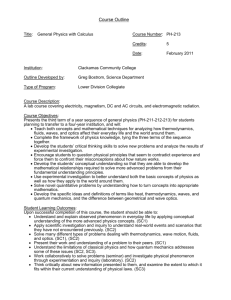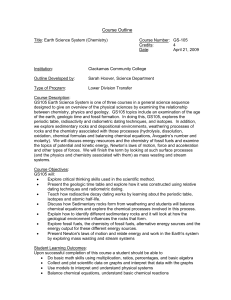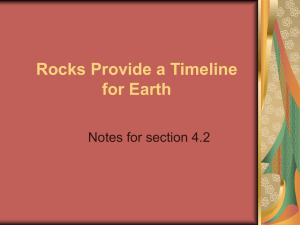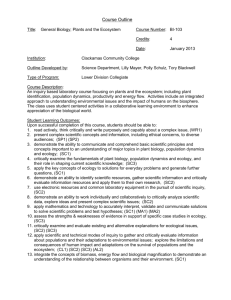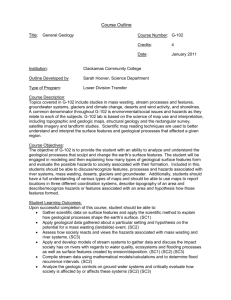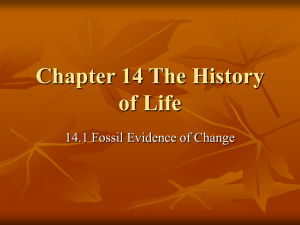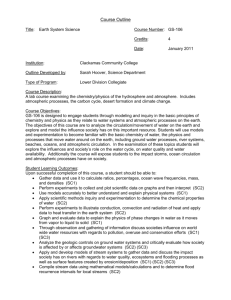GS 105 - Clackamas Community College
advertisement
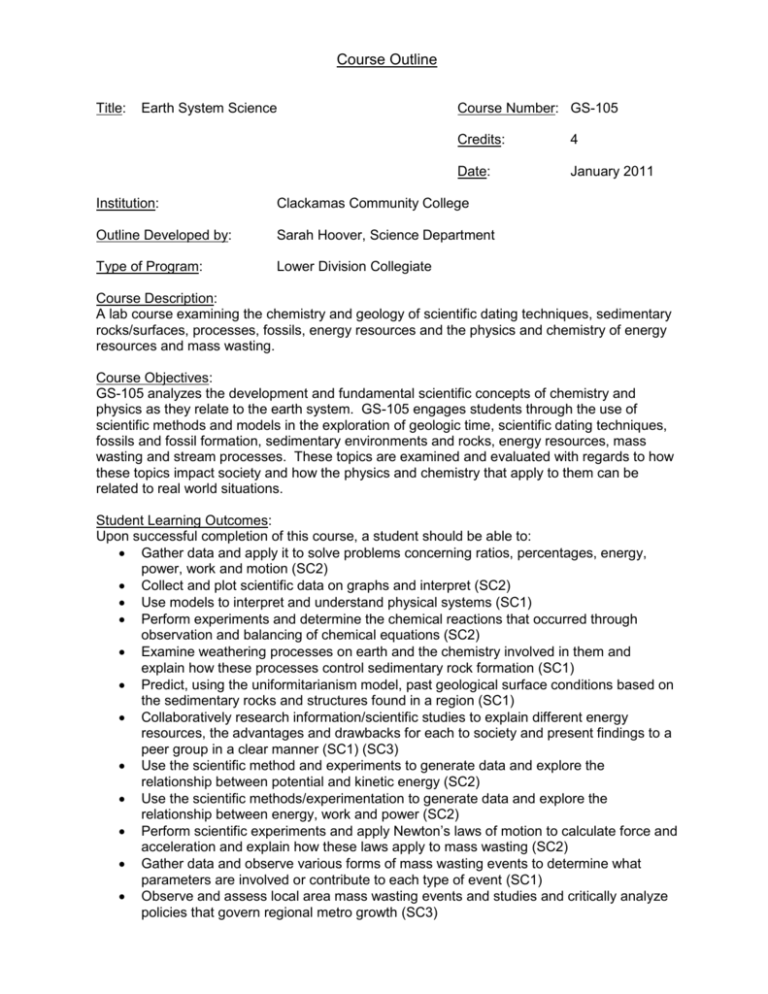
Course Outline Title: Earth System Science Course Number: GS-105 Credits: 4 Date: January 2011 Institution: Clackamas Community College Outline Developed by: Sarah Hoover, Science Department Type of Program: Lower Division Collegiate Course Description: A lab course examining the chemistry and geology of scientific dating techniques, sedimentary rocks/surfaces, processes, fossils, energy resources and the physics and chemistry of energy resources and mass wasting. Course Objectives: GS-105 analyzes the development and fundamental scientific concepts of chemistry and physics as they relate to the earth system. GS-105 engages students through the use of scientific methods and models in the exploration of geologic time, scientific dating techniques, fossils and fossil formation, sedimentary environments and rocks, energy resources, mass wasting and stream processes. These topics are examined and evaluated with regards to how these topics impact society and how the physics and chemistry that apply to them can be related to real world situations. Student Learning Outcomes: Upon successful completion of this course, a student should be able to: Gather data and apply it to solve problems concerning ratios, percentages, energy, power, work and motion (SC2) Collect and plot scientific data on graphs and interpret (SC2) Use models to interpret and understand physical systems (SC1) Perform experiments and determine the chemical reactions that occurred through observation and balancing of chemical equations (SC2) Examine weathering processes on earth and the chemistry involved in them and explain how these processes control sedimentary rock formation (SC1) Predict, using the uniformitarianism model, past geological surface conditions based on the sedimentary rocks and structures found in a region (SC1) Collaboratively research information/scientific studies to explain different energy resources, the advantages and drawbacks for each to society and present findings to a peer group in a clear manner (SC1) (SC3) Use the scientific method and experiments to generate data and explore the relationship between potential and kinetic energy (SC2) Use the scientific methods/experimentation to generate data and explore the relationship between energy, work and power (SC2) Perform scientific experiments and apply Newton’s laws of motion to calculate force and acceleration and explain how these laws apply to mass wasting (SC2) Gather data and observe various forms of mass wasting events to determine what parameters are involved or contribute to each type of event (SC1) Observe and assess local area mass wasting events and studies and critically analyze policies that govern regional metro growth (SC3) Critically evaluate fossils and the current explanations on fossil formation to determine how/why organisms are preserved in the geologic record (SC2) Apply mapping techniques and fossil data to stratigraphy in order to correlate rock units in a region and relate this information to how scientists develop geological histories (SC1) (SC2) Collect data using isotopes to determine half-life values for elements and illustrate radiometric dating processes used in science. (SC1) Length of Course: 33 lecture and 33 lab hours Grading Method: Letter grade (A-F) or Pass/No Pass Prerequisites: None Recommended: Pass MTH-065 or placement in MTH-095. Major Topic Outline: Critical thinking, earth’s age, geologic time and relative dating Absolute dating, radioactivity, periodic table, isotopes and ½ lives Intro to sedimentary rocks and weathering processes, balancing chemical equations and chemical formulas Continue physical and chemical weathering, Avogadro’s number, calculating molarity and chemical reactions Sedimentary rocks and environments Energy resources, chemistry of fossil fuels, alternative resource, kinetic and potential energy Energy in Earth’s systems, Energy and work, Newton’s laws of motion, Force and acceleration, types of force Mass Wasting Relative dating techniques Fossils and fossil formation Radiometric dating Physical and Chemical reactions Sedimentary rocks Topographic maps Force and work Energy and power Gravity and landslide physics Energy resource presentations CCC AAOT/ASOT GENERAL EDUCATION OUTCOMES COURSE OUTLINE MAPPING CHART Course Title and Number: GS-105 Earth System Science Mark outcomes addressed by this course: Mark “C” if this course completely addresses the outcome. Students who successfully complete this course are likely to have attained this learning outcome. Mark “S” if this course substantially addresses the outcome. More than one course is required for the outcome to be completely addressed. Students who successfully complete all of the required courses are likely to have attained this learning outcome. Mark “P” if this course partially addresses the outcome. Students will have been exposed to the outcome as part of the class, but the class is not a primary means for attaining the outcome and assessment for general education purposes may not be necessary. As a result of completing the AAOT /ASOT general education requirements, students will be able to: WR: Writing Outcomes 1. Read actively, think critically, and write purposefully and capably for academic and, in some cases, professional audiences. 2. Locate, evaluate, and ethically utilize information to communicate effectively. 3. Demonstrate appropriate reasoning in response to complex issues. SP: Speech/Oral Communication Outcomes 1. Engage in ethical communication processes that accomplish goals. 2. Respond to the needs of diverse audiences and contexts. 3. Build and manage relationships. MA: Mathematics Outcomes 1. Use appropriate mathematics to solve problems. 2. Recognize which mathematical concepts are applicable to a scenario, apply appropriate mathematics and technology in its analysis, and then accurately interpret, validate, and communicate the results. AL: Arts and Letters Outcomes i 1. Interpret and engage in the Arts & Letters, making use of the creative process to enrich the quality of life. 2. Critically analyze values and ethics within a range of human experience and expression to engage more fully in local and global issues. SS: Social Science Outcomes 1. Apply analytical skills to social phenomena in order to understand human behavior. 2. Apply knowledge and experience to foster personal growth and better appreciate the diverse social world in which we live. SC: Science or Computer Science Outcomes 1. Gather, comprehend, and communicate scientific and technical information in order to explore ideas, models, and solutions and generate further questions. 2. Apply scientific and technical modes of inquiry, individually, and collaboratively, to critically evaluate existing or alternative explanations, solve problems, and make evidence-based decisions in an ethical manner. 3. Assess the strengths and weaknesses of scientific studies and critically examine the influence of scientific and technical knowledge on human society and the environment. CL: Cultural Literacy Outcome ii 1. Identify and analyze complex practices, values, and beliefs and the culturally and historically defined meanings of difference. IL: Information Literacy Outcomesiii 1. Formulate a problem statement. 2. Determine the nature and extent of the information needed to address the problem. 3. Access relevant information effectively and efficiently. 4. Evaluate information and its course critically. 5. Understand many of the economic, legal, and social issues surrounding the use of information. “Arts and Letters” refers to works of art, whether written, crafted, designed, or performed and documents of historical or cultural significance. ii Must be embedded in a course that meets the outcomes for Arts and Letters, Social Science, or Science/Computer Science. iii Must be embedded in the general education required Writing courses Revised 2010-2011 to reflect Statewide AAOT outcomes i S S S
